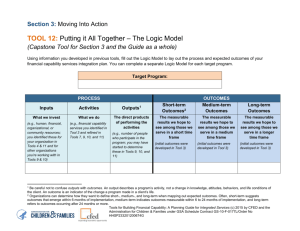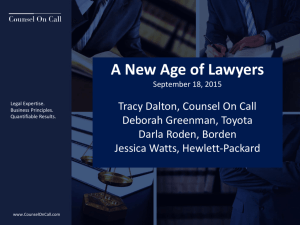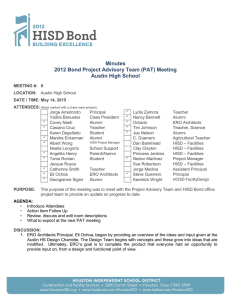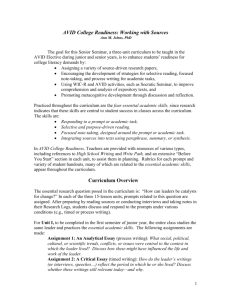STRATEGIC PLANNING - Center for Community Futures
advertisement
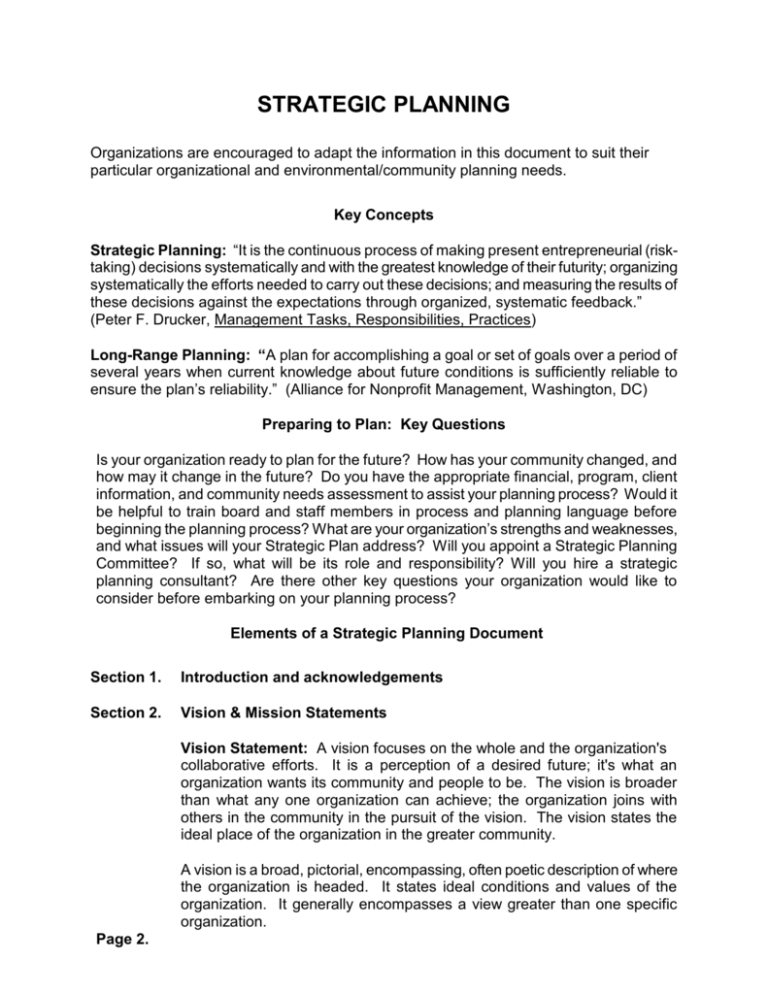
STRATEGIC PLANNING Organizations are encouraged to adapt the information in this document to suit their particular organizational and environmental/community planning needs. Key Concepts Strategic Planning: “It is the continuous process of making present entrepreneurial (risktaking) decisions systematically and with the greatest knowledge of their futurity; organizing systematically the efforts needed to carry out these decisions; and measuring the results of these decisions against the expectations through organized, systematic feedback.” (Peter F. Drucker, Management Tasks, Responsibilities, Practices) Long-Range Planning: “A plan for accomplishing a goal or set of goals over a period of several years when current knowledge about future conditions is sufficiently reliable to ensure the plan’s reliability.” (Alliance for Nonprofit Management, Washington, DC) Preparing to Plan: Key Questions Is your organization ready to plan for the future? How has your community changed, and how may it change in the future? Do you have the appropriate financial, program, client information, and community needs assessment to assist your planning process? Would it be helpful to train board and staff members in process and planning language before beginning the planning process? What are your organization’s strengths and weaknesses, and what issues will your Strategic Plan address? Will you appoint a Strategic Planning Committee? If so, what will be its role and responsibility? Will you hire a strategic planning consultant? Are there other key questions your organization would like to consider before embarking on your planning process? Elements of a Strategic Planning Document Section 1. Introduction and acknowledgements Section 2. Vision & Mission Statements Vision Statement: A vision focuses on the whole and the organization's collaborative efforts. It is a perception of a desired future; it's what an organization wants its community and people to be. The vision is broader than what any one organization can achieve; the organization joins with others in the community in the pursuit of the vision. The vision states the ideal place of the organization in the greater community. A vision is a broad, pictorial, encompassing, often poetic description of where the organization is headed. It states ideal conditions and values of the organization. It generally encompasses a view greater than one specific organization. Page 2. Mission Statement: Missions are the basic approaches that will be used to achieve a program(s) purpose(s). They include strategies for achieving a better focusing of resources on the organization's goals. Mission Statements serve as a tool for focusing planning, goals, priorities and resource allocation to achieve desired results. They share why your organization exists and its basic values with your stakeholders and the public. Section 3. Organizational & Community Information Profile A narrative description of the organization (e.g. history, current membership profile, etc.) and the community in which the organization is located (e.g. demographic information, poverty, unemployment, health, nutrition, housing conditions, homelessness, crime rates, business and cultural activity, etc.). Section 4. Problem Statement a. b. c. d. What is the problem? What is the cause? Who is affected? Where are they located? The problem statement is the end result of the organization's analysis. It should be clear and concise, and should be clearly drawn from the data and not be included simply to justify current program(s). Prioritizing Problems: This will not be easy. Some problems may be deleted. The organization will have to develop some standards for the deletion of problems. To rank or prioritize problems, the questions needed to rank or order the problems must be established before the debate begins or the setting of these priorities will be subjective and at the whim of the person(s) with the most influence. Some items to assist in quantifying needs might be: o o o o o o Number of people affected Depth of problem Organization's ability to positively improve the situation Length of time needed Amount of funds necessary Probable impact A scale must be developed (e.g. 0-5; 1-5; 1-10) establishing what is the most important concern or need and which is the least. Establish this prioritizing system with its scale and considerations before the problems are identified. Page 3. Section 5. Program Goals, Objectives, Activities and Delivery Strategies Note: Regarding Goals & Objectives, one or the other must be quantifiable. Goal Statements: Goals should clearly reflect what the organization intends to achieve over a yearly or multi-year time frame. Goals should have the following characteristics: o o o o Be quantifiable What will be achieved? Where will it be achieved? Who will benefit? Establish Objectives: Objectives are more specific, concrete, and measurable than goals. They represent steps, increments, or milestones on the road to reaching the goals. They should be clear and concise: they should be specific, measurable and attainable. Ideally, they should also include both a time and cost factor. Although they should be realistic and attainable, objectives should be a challenge. They describe a series of effects that must happen if program is to achieve its goals. Outcomes Identification: Outcomes are expected results from attaining goals. Develop Strategies: Review various approaches. How will resources be utilized? Identify Resources: What resources will be used to assist in achieving goals? Resources can include money, staff, supplies, volunteers and equipment. Establish Milestones: What will be accomplished by year end? Should be measurable in a specific period of time. Activities: List and describe activities to achieve goals; list the activities in order of accomplishment. Section 6. Outcome Evaluation Strategy The evaluation narrative should be an integral part of the strategic planning process with a separate narrative to describe how the evaluation will be accomplished. A well-developed evaluation process can help an organization evaluate its success. This allows the organization to see if it has Page 4 attained the purposes of its programs and projects as established in the Strategic Plan. By carrying out the evaluation, the organization is able to assess the value and purpose of its programs, and make administrative and programmatic adjustments for succeeding years. Evaluations may include one or more of the following types: o Program Evaluation - Measures the goal. It tells you if you accomplished your goals by asking yes or no questions. o Process Evaluation - Evaluates what is going on and whether or not you are operating as planned. It asks the question, "How well did you do what you said you were going to do?" o Impact Evaluation - Asks the question, "What difference did it make and are there any unintended benefits?" This produces a self-evaluation of the organization's programs and projects, which in turn gives insight into the organization's strengths, weaknesses, accomplishments and failures. Thus, organizations are able to make informed decisions about future organizational direction on the basis of the evaluation and its needs assessment. Section 7. Evaluation & Monitoring Plan The organization should adopt a policy that it will regularly monitor and periodically evaluate programs with regard to process and outcomes. Who will evaluate? The organization must identify who and how a program will be evaluated (e.g Policies & Procedures). How will the evaluation findings be fed back into the strategic planning process? The organization may annually appoint an Evaluation Team (e.g. comprised of Board members, management, program staff, and members from the community at-large). John Ochoa California Department of Community Services and Development 700 North 10th Street, Room 258 Sacramento, Ca 95814-0338 (916) 341-4327 (Voice/Fax) E-mail: jochoa@csd.ca.gov Strategic Planning: Strategies for Impact Preparing to Plan: Key Questions: A. Is your organization ready to plan for the future? 1) Yes 2) No Notes: B. How has you community changed, and how may it change in the future? 1) 2) Notes: C. Do you have the appropriate financial, program, client information, and community needs assessment to assist your planning process? 1) Yes 2) No Notes: D. Would it be helpful to train board and staff members in process and planning language before beginning the planning process? 1) Yes 2) No Notes: E. What are your organization’s strengths and weaknesses, and what issues will your Strategic Plan address? 1) 2) Notes: F. Will you appoint a Strategic Planning Committee? If so, what will be its role and responsibility? 1) Yes 2) No Notes: G. Will you hire a strategic planning consultant? 1) Yes 2) No Notes: H. Are there other key questions your organization would like to consider before embarking on your planning process? 1) 2) Notes: John Ochoa California Department of Community Services and Development 700 North 10th Street, Room 258 Sacramento, Ca 95814-0338 (916) 341-4327 (Voice/Fax); E-mail: jochoa@csd.ca.gov



